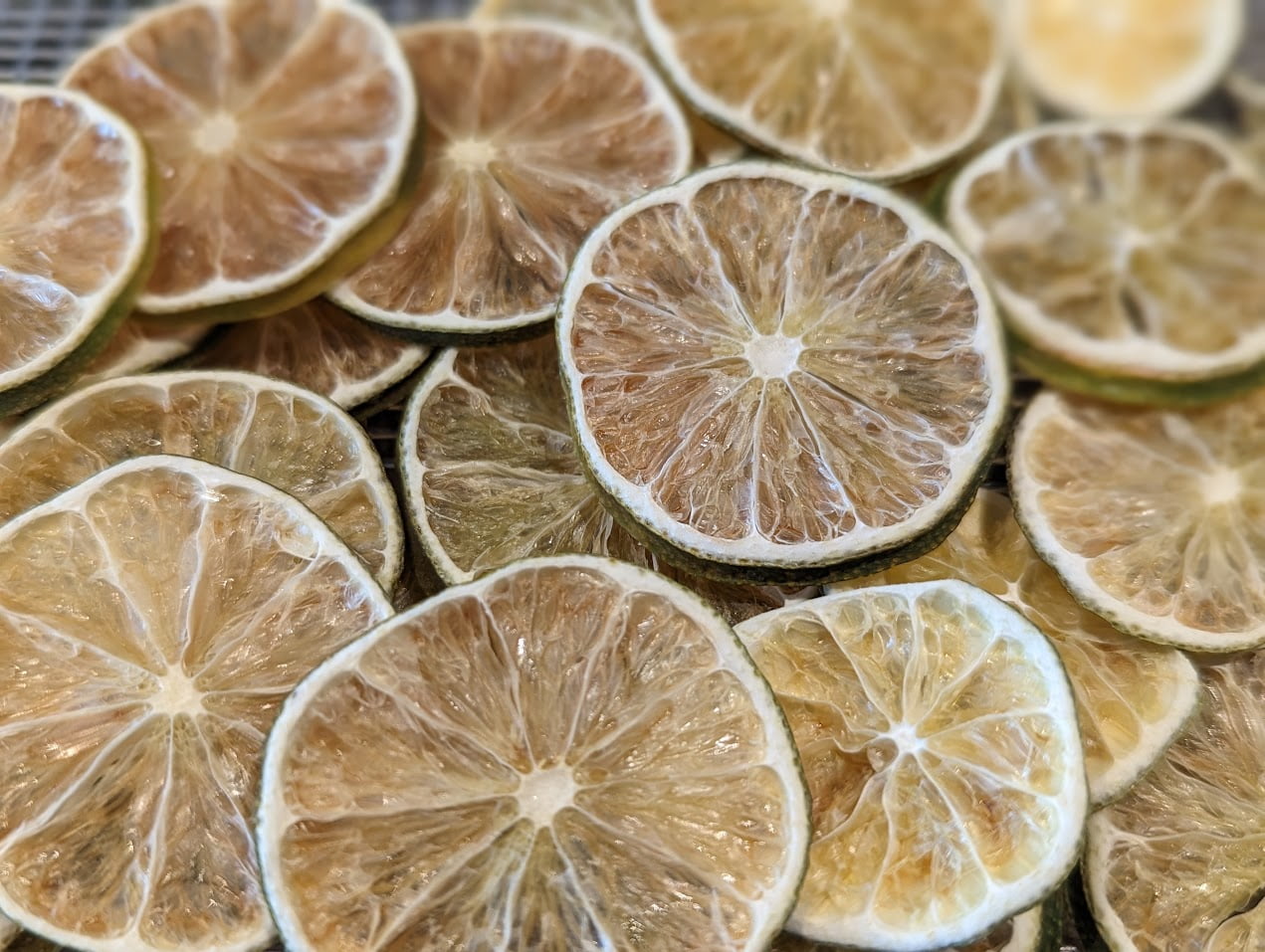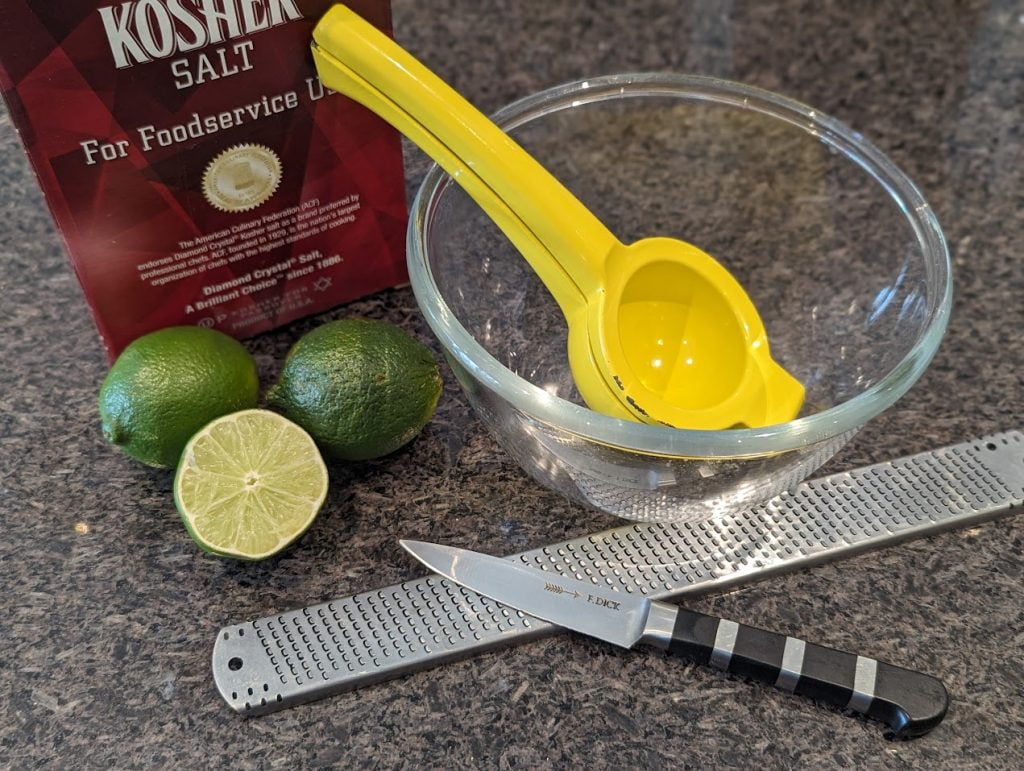
Dehydrated Lime and Lime Juice Infusion
Lime, with its invigorating zest and tangy essence, is a beloved ingredient in culinary pursuits worldwide. Capturing the essence of this citrus gem in a concentrated form opens the doors to a myriad of culinary possibilities. In this article, I embark on a flavorful journey by experimenting with two distinct methods for crafting lime flavoring: dehydrated lime and lime juice infusion.
Experiment 1: Dehydrated Lime

Dehydrating lime offers a unique approach to preserving its vibrant flavor while intensifying its citrusy essence. Dehydrated limes can be found in many recipes, and potpourri. The pros, if this method works, is its ease of use, i.e., all is needed it to wash, cut, and dehydrate the limes. The unknown cons of this method are the potential for the pith to add too many bitter notes to the finished product. If this method doesn’t work, I will be removing the zest, then peeling the limes and dehydrating the lime slices and zest. (Hint: It didn’t work)
Here’s how I embarked on this delectable experiment:
Ingredients:
- 2 Fresh limes
Instructions:
- Preparation: Wash the limes thoroughly under warm running water to remove any dirt or residue. Pat them dry with a clean towel.
- Slicing: Using a sharp knife or a mandoline slicer (please use a cut resistant glove with a mandoline), thinly slice the limes into uniform rounds. Aim for slices that are approximately 3 mm (1/8″) to 6mm (1/4″) thick.
- Dehydration Process: Arrange the lime slices in a single layer on dehydrator trays, ensuring proper airflow between each slice. Set the dehydrator to a low temperature, typically around 135-145 degrees Fahrenheit (57-63 degrees Celsius), and allow the limes to dehydrate for 10 – 14 hours, or until they are completely dried and brittle. We use a lower temperature to help preserve the colour of the limes. If you would like to get the limes dehydrated quicker turn it to 160 degrees Fahrenheit.
- Cooling and Storage: Once dehydrated, remove the lime slices from the dehydrator and let them cool to room temperature. Transfer the dried lime slices to a spice grinder and grind until fine. Run through a sieve and remove any large pieces. Keep repeating this step with large pieces until done.
- Taste Test: Taste it, if it works then move to a spice container and keep in a cool dry place.
Note: Some newer ovens allow you to use convection at very low temperatures. This is safe and easy alternative to a dehydrator, and doesn’t require an additional piece of equipment.
Experiment 2: Lime Juice, Zest, and Salt Infusion

Infusing lime juice, lime zest, and salt together may create a potent flavoring that embodies the essence of lime in every sprinkle. I have successfully used salt as a substrate to make Habanero salt / flavouring as a retail product years ago. This was done through two methods, one was to extract the oil from dried habaneros, the other method was to make a heavy brine and infuse the habanero liquid right into the salts. I would expect this could work with lime, the unknown is weather or not the lime flavouring will be strong enough to overpower the salt.
Ingredients:
- 2 Fresh limes
- 60g Salt
Instructions:
- Preparation: Wash the limes thoroughly and pat them dry. Using a zester or a fine grater, zest the outer peel of the limes, being careful to avoid the bitter white pith beneath the zest.
- Juicing: Cut the zested limes in half and extract the juice using a citrus juicer or by hand.
- Blending: In a bowl, combine the freshly squeezed lime juice with the zest and salt to create a slurry like paste.
- Dehydration Process: Spread the lime juice, zest, and salt mixture evenly onto parchment paper OR a silicone baking mat. Spread out as thin as possible, the larger the surface area the quicker it will dehydrate. Place sheet with lime slurry into dehydrator at 160 degrees Fahrenheit or 71 degrees Celsius. Allow the mixture to dehydrate for 8-10 hours, or until it has completely dried into a granular consistency. Consider stirring the slurry every couple of hours.
- Cooling and Storage: Once dehydrated, remove the lime-infused salt from the dehydrator and let it cool to room temperature. Transfer the flavored salt into a sealed container or a spice jar for storage. Store it in a cool, dry place.
As I embark on these two distinct experiments, I am poised to unlock the secrets of dry lime flavoring and delve into the creative possibilities it offers in culinary pursuits. By dehydrating lime slices to intensify their citrus essence, and by infusing lime juice, zest, and salt together for a zesty seasoning blend, I anticipate we will discover the true essence of lime in every sprinkle. Stay tuned as I conduct these experiments and document the process in future articles, inviting you to join on this flavorful journey and embrace the endless culinary adventures that await!
Prev: Exploring The Zest Of Lime
